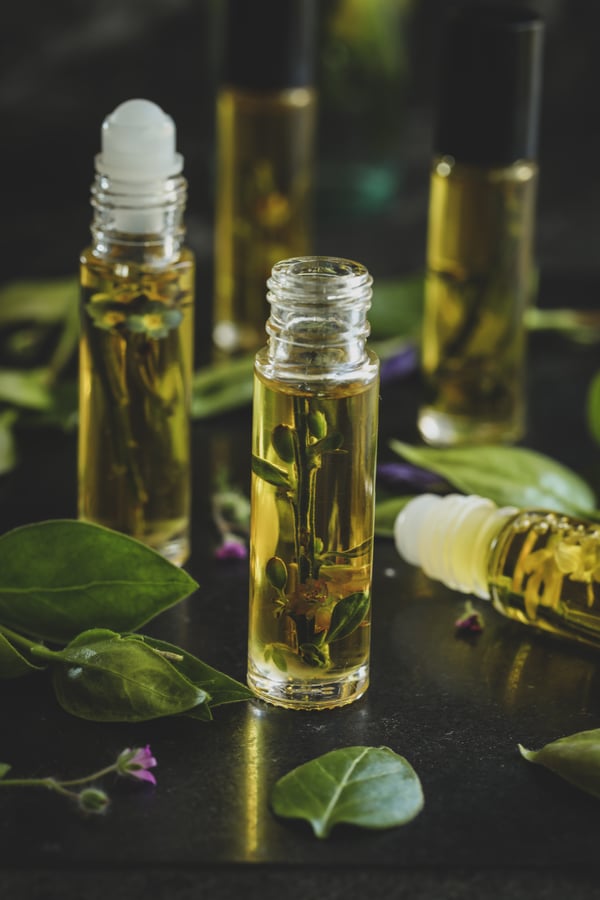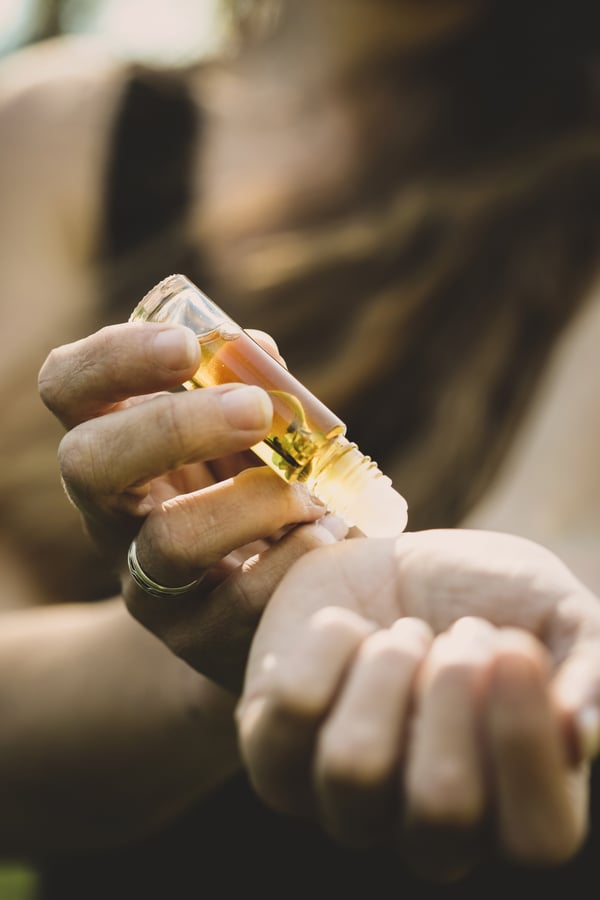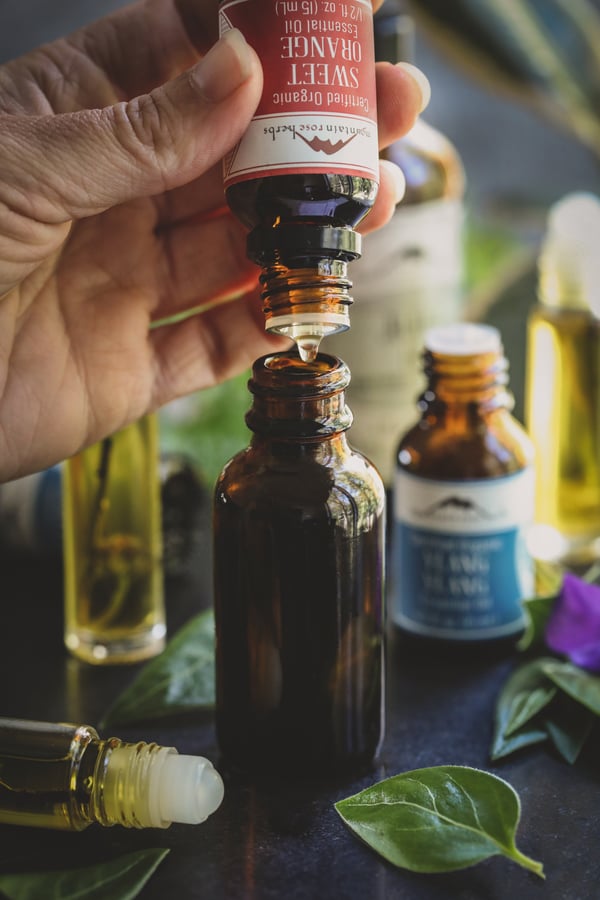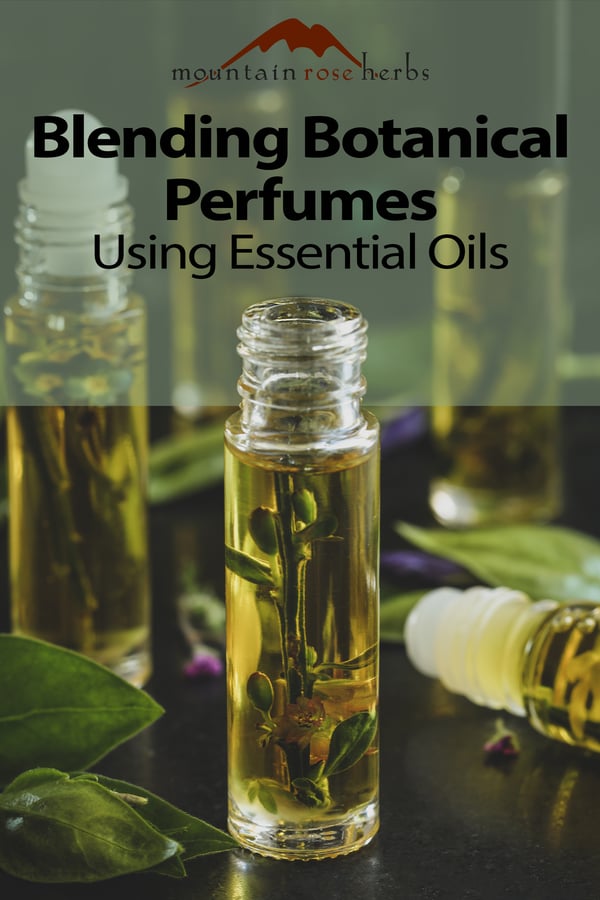Blending botanical perfumes using essential oils is one of the beautiful ways that we can incorporate pure oils into our daily lives. There’s nothing quite like blending a favorite floral aroma with a little spice or a little citrusy zest and grounding it with a rooty, earthy scent. But there are many ways that perfume blending can go awry! Just because we love the aroma of lavender, and geranium, and vanilla doesn’t necessarily mean we’ll love the three together. To keep aromatic perfume blends balanced, there are a couple of essential oil categories we need to keep in mind. As we say in the Herbal Academy’s Natural Perfumery Course, “Although training one’s nose to distinguish subtle nuances of scent takes years, there is always value in improving one’s scent awareness. One can identify note, fragrance intensity, fragrance category, and eventually, the subtle difference within a fragrance category.”
Botanical Perfumes are Built on Notes
One of the primary ways essential oils are categorized when blending for aroma is by “note.” An essential oil’s note is determined by how quickly the essential oil evaporates. Essential oils that evaporate quickly, over minutes or hours, are called “top” or “head” notes, while those that evaporate at a moderate rate, usually over several hours, are called “middle” or “heart” notes, and the most viscous essential oils that evaporate very slowly are called “base” notes.
These categories are not clearly delineated but produce more of a spectrum of fragrance, like a musical scale, and are often relative—an aroma may be a top note in some combinations and a middle note in others. Chemical composition variability can also make a difference: the Virginia cedarwood essential oil you buy today might play a middle note role, whereas the Virginia cedarwood you bought last month might have been more of a base note. The citrus essential oils are all top notes, whereas many of the floral or herbal essential oils, like lavender and geranium, are middle notes. As one might expect from energetics, the rooty and woody essential oils, such as vetiver and sandalwood, are typically base notes.
If one combines only top notes, the aroma will initially be vibrant but will disappear quickly. If one adds some middle notes to the blend, the overall aroma will last a little longer, with the top notes fading, leaving the middle notes behind. If one adds in one or more base notes to anchor the other aromas, the overall fragrance will last longer still, and there will be more depth and complexity to the fragrance as it changes over time.
A harmonious combination of top, middle, and base notes is combined to form an aromatic “chord,” also known as an “accord.” Groups of essential oils in the same note category or a combination of notes may be grouped together to form an accord, to which other essential oils may be added in various combinations to create different final fragrances.
Accords are used in perfume making for a variety of purposes, including replacing or extending notes, and adding depth, originality, creativity, and/or a story point. Multiple chords in a perfume are like those wonderful layers in great storytelling, seamlessly blended to create a synergy greater than the sum of its parts.
For example, a blend of palmarosa, bergamot, vetiver, vanilla, sandalwood, and ylang ylang could be combined to form a chord that is used as a stand-alone fragrance or used with a combination of other essential oils as a substitute for rose.
Examples of top notes commonly used in perfumery include juniper berry, neroli, and bergamot. Middle notes include clary sage, palmarosa, and jasmine absolute. Base notes include myrrh, patchouli, and ylang ylang
There’s not one single formula for combining notes into an appealing blend, but as you start out experimenting with perfumery you could start with a ratio of top (3), middle (2), and base (1) -- that is 3 parts of top note to 2 parts middle note to 1 part base note. Or, alternatively, 4:3:1. These parts are generally measured in drops. For example, you could start with 3 drops of neroli, 2 drops of lavender, and 1 drop of patchouli. This method does not need to be confined to one essential oil per note, though! Your top note could be 2 drops of neroli and 1 drop of bergamot, for example. It’s best to start small as you experiment with new blends, but once you find a combination that you like, you can use the same ratio with more drops per part.
Factor in Fragrance Families
Notes are based on the volatility, viscosity, and evaporation rates of aromatics, but how do we describe the fragrance or odor of an essential oil? There are a number of odor types in perfumery, both for individual aromas as well as for certain perfumery combinations. Odor types one might include earthy, floral, fruity, herbaceous, minty, resinous, smoky, and spicy. A couple of the less well-known fragrance families include agrestic and balsamic. Agrestic essential oils, like oakmoss, are reminiscent of the outdoors (woods, meadows, etc.). Balsamic aromas are sweet, heavy, warm, and vanilla-like, such as Peru balsam.
One might also consider a fragrance’s intensity when blending. For instance, vetiver has a stronger fragrance than sandalwood, even though they are in the same “woody” fragrance family; and lime smells stronger than orange. When these intensities are compared to each other, each essential oil can be given a relative rating or blending factor, which is sometimes used in mathematical formulae to balance the fragrance of a therapeutic blend. Blending factor is not used so much in perfumery, yet fragrance intensity can still play a role in determining the proportions of essential oils in your final perfume.
How to Blend Natural Perfume
Fragrance blends range from very simple to inordinately complex. A simple blend might only have two ingredients. Essential oils with woody aromas, such as sandalwood, combine well with one other essential oil, such as vanilla absolute, rose absolute, or cardamom essential oil. Some blends stay within a fragrance category, such as a floral blend or a citrus blend. These may include a base note, such as vanilla, sandalwood, or vetiver, to give the overall fragrance depth while keeping the basic blend very simple.
An excellent approach to any kind of essential oil blending is to first blend your fragrant extracts in a small, dark-colored glass bottle with an orifice reducer to use as your stock bottle. You can tweak this blend over time since it is separate from the final product. You can also use it in several different products, such as roll-ons, lotions, creams, bath bombs, solid perfumes, etc. The concentration of the stock blend you would include in your final product would be whatever were appropriate for that product or recipe.
Since botanical perfumes are usually applied to a small area of the body, they can incorporate overall higher concentrations of essential oil than what is usually recommended in dilution charts. That said, it is always best to use the lowest dilution necessary to achieve the desired effect. Using a stronger perfume does not make it last longer or smell better. Also, keep in mind that one should always watch out for personal allergies or sensitivities and avoid certain essential oils when pregnant or breastfeeding. It’s important to do your research before blending and using a perfume!
Generally speaking, perfume blends are between 15% and 30% essential oil (for example, approximately 20 drops of essential oil and/or absolute would be combined with 80 drops of carrier oil or alcohol). However, although there may be times when you might choose to use 20 or 30% essential oil in a perfume product, it is a good idea, especially to start, to use dilutions of 10% or less. For most essential oils and oil blends, dilutions of 3-5% will be adequate to produce a beautifully scented product. Absolutes and CO2 extracts often tend to have more potent aromas even than essential oils, so the type of botanical extract used can have a strong effect on the dilution necessary to achieve your fragrance goal, as will the type of carrier or style of perfume. Start small and build only as necessary.
Some essential oils have maximum concentration recommendations that should still be followed, even for perfumery. It is important to understand why certain essential oils have dilution level restrictions and to maintain safe dilution levels for any skin-irritating, skin-sensitizing, or phototoxic essential oils. For example, the overall dilution of jasmine absolute in a final product should not exceed 0.7% to prevent possible skin irritation and sensitization, especially in fragrance-sensitive individuals.
Botanical Perfume Recipe Blend
This recipe comes from the Herbal Academy’s Natural Perfumery Course, which includes all the information you need to start blending your own botanical perfumes at home today, including over 20 recipes, a special collection of perfumery plant monographs, simple rituals for incorporating them into your lifestyle, expert guidance, and beautifully illustrated downloads for safety, sustainability, techniques and more!
Orange Blossom Special - From Herbal Academy’s Natural Perfumery Course
This roll-on perfume is a blend of orange and floral fragrances. We have used citrus-family top notes with floral middle and base notes. Note the ratio of essential oils in this blend—top:middle:base = 3:2:1
To make this recipe, you’ll need a 10-mL glass roll-on bottle.
Ingredients
- 9 mL jojoba oil
- 3 drops sweet orange essential oil (top note)
- 2 drops palmarosa - middle note (middle note)
- 1 drop ylang ylang essential oil (base note)
- 1 drop vitamin E oil
Optional Ingredients
- 2 drops rose absolute (middle note) can be used in addition to or instead of palmarosa
- 1 drop neroli essential oil (top note)
Directions
- Combine all ingredients in a 10-mL glass roll-on bottle.
- Shake gently.
- Label and keep in a cool, dark place for up to 1 year.
Blending your own botanical perfumes is a beautiful, time-tested way to infuse your life with the delightful fragrances of the plants that speak to you the most. Perfumery is an art form that, like herbalism, requires an intimate knowledge of plants and how they synergize with each other. It also involves a willingness and ability to trust intuition, imagination, and the wisdom that is within you. Are you ready to take this aromatic journey?
WANT TO learn more about aromatherapy from the Herbal Academy?
Check Out Their Natural Perfumery Course!
Best Carrier Oils for Aromatherapy
Solid Perfume Recipes
10 Essential Oils for Clarity and Focus













